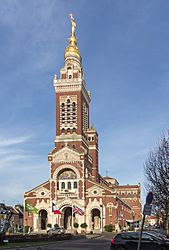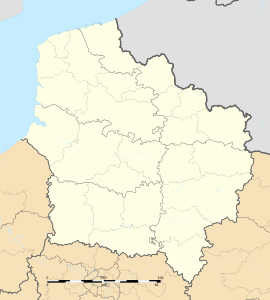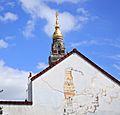Albert, Somme facts for kids
Quick facts for kids
Albert
|
||
|---|---|---|

Basilica of Notre-Dame de Brebières
|
||
|
||
| Country | France | |
| Region | Hauts-de-France | |
| Department | Somme | |
| Arrondissement | Péronne | |
| Canton | Albert | |
| Intercommunality | Pays du Coquelicot | |
| Area
1
|
13.8 km2 (5.3 sq mi) | |
| Population
(2021)
|
9,781 | |
| • Density | 708.8/km2 (1,836/sq mi) | |
| Time zone | UTC+01:00 (CET) | |
| • Summer (DST) | UTC+02:00 (CEST) | |
| INSEE/Postal code |
80016 /80300
|
|
| Elevation | 42–121 m (138–397 ft) (avg. 67 m or 220 ft) |
|
| 1 French Land Register data, which excludes lakes, ponds, glaciers > 1 km2 (0.386 sq mi or 247 acres) and river estuaries. | ||
Albert is a town in the Somme department in northern France. It is located about halfway between the cities of Amiens and Bapaume. Albert is well-known for its important role in both World War I and World War II.
Contents
History of Albert
Albert began as a Roman outpost around 54 BC. It was first named after the local river, the Ancre. Later, it was renamed Albert after it came under the control of Charles d'Albert, duc de Luynes.
Albert and World War I
Albert was a very important place during World War I, especially during the Battle of the Somme. Many people visit Albert today to learn about its World War I history.
The Basilica of Our Lady of Brebières in Albert had a famous statue on top of its tower. This statue, designed by sculptor Albert Roze, showed Mary and baby Jesus and was known as the Golden Virgin. On January 15, 1915, during World War I, a shell hit the statue. It leaned over to a nearly horizontal position but did not fall. It stayed like that until 1918, when more shelling destroyed the tower.
A chaplain named Rupert Inglis wrote about seeing the leaning statue in 1915. He described how amazing it was that the statue had not fallen, even though the church and village were badly damaged.
In March 1918, the German army took control of Albert again. To stop the Germans from using the church tower as a machine gun post, the British army bombed the basilica. The statue finally fell in April 1918 and was never found again.
After the war, Albert was completely rebuilt. The town's main streets were made wider and changed. The Basilica, however, was rebuilt exactly as it looked before the war. The new statue on top is a perfect copy of the original Golden Virgin. You can see a war memorial with an image of the Leaning Virgin in the Abri (Shelter) Museum. This museum is in underground shelters that protected Albert's residents during air raids in World War II.
The town of Albert is also mentioned in a short story called "The Garden of Forking Paths" by the Argentine writer Jorge Luis Borges. In the story, Albert is where a British artillery park is located during World War I.
Not far from Albert, about 9 kilometers away, is the Beaumont-Hamel Newfoundland Memorial. This memorial honors soldiers from Dominion of Newfoundland who died during World War I. It was opened in 1925 and is one of only two National Historic Sites of Canada located outside of Canada.
Liberation of Albert in World War II
On September 1, 1944, the 7th Battalion of the Green Howards, a British army unit, was moving through northern France. They arrived near Albert and learned that a strong German force was in the town.
That evening, two companies of the Green Howards moved towards Albert. They set up positions to stop German vehicles. Soon, they heard explosions in Albert, and later, German vehicles approached. A German armored car and a scout car led a convoy of trucks. The British let most of the convoy pass. When the last truck, a tank, and a half-track armored vehicle came close, the British opened fire.
The tank fired back, but the half-track was hit by a P.I.A.T. (a type of anti-tank weapon) grenade. It lost control and exploded. The British lost one vehicle, but they caused many casualties among the German soldiers.
Captain Murray, who was leading the British soldiers, and two others went further down the track. They met a German patrol and quickly opened fire, making the Germans run into a nearby wood. The British then fired more weapons into the wood.
The next morning, the British found about thirty to forty burnt-out German vehicles in the wood. It was clear the Germans had retreated in a hurry.
At 6 AM, the British Battalion moved into Albert. There was no resistance, and the people of Albert came out to welcome them. The Green Howards had "quite a celebration" that day. Captain Murray's decision to fight the enemy at night helped save the people of Albert from a potential disaster.
During this four-hour operation, the Green Howards lost two men: Sergeant Harland Matthews (27) and Private Richard Westcott (19). Captain Murray was awarded the Military Cross for his bravery and leadership. His courage inspired his men, who caused many casualties and destroyed many enemy vehicles.
Twin towns
Albert is twinned with the British town of Ulverston in Cumbria. The two towns often play football together at Easter, competing for the Cyril Barker Shield. Albert and Ulverston take turns hosting the match each year.
Albert is also twinned with the German towns of Aldenhoven and Niesky. After World War I, the English city of Birmingham "adopted" Albert. Citizens of Birmingham helped fund a new building for the elderly, and one of Albert's main streets is named Rue de Birmingham (Birmingham Street).
Population
| Historical population | ||
|---|---|---|
| Year | Pop. | ±% p.a. |
| 1968 | 10,960 | — |
| 1975 | 11,784 | +1.04% |
| 1982 | 10,894 | −1.12% |
| 1990 | 10,010 | −1.05% |
| 1999 | 10,065 | +0.06% |
| 2007 | 10,027 | −0.05% |
| 2012 | 9,899 | −0.26% |
| 2017 | 9,928 | +0.06% |
| Source: INSEE | ||
The table above shows how the population of Albert has changed over the years.
Notable residents
The French opera singer Xavier Depraz was born in Albert on April 22, 1926.
Images for kids
See also
 In Spanish: Albert (Somme) para niños
In Spanish: Albert (Somme) para niños







